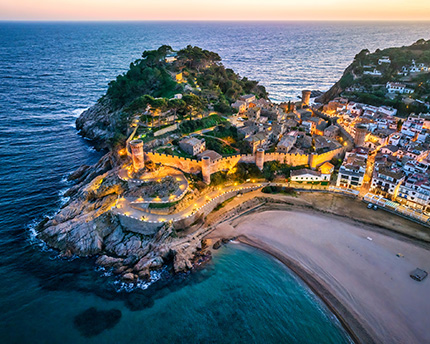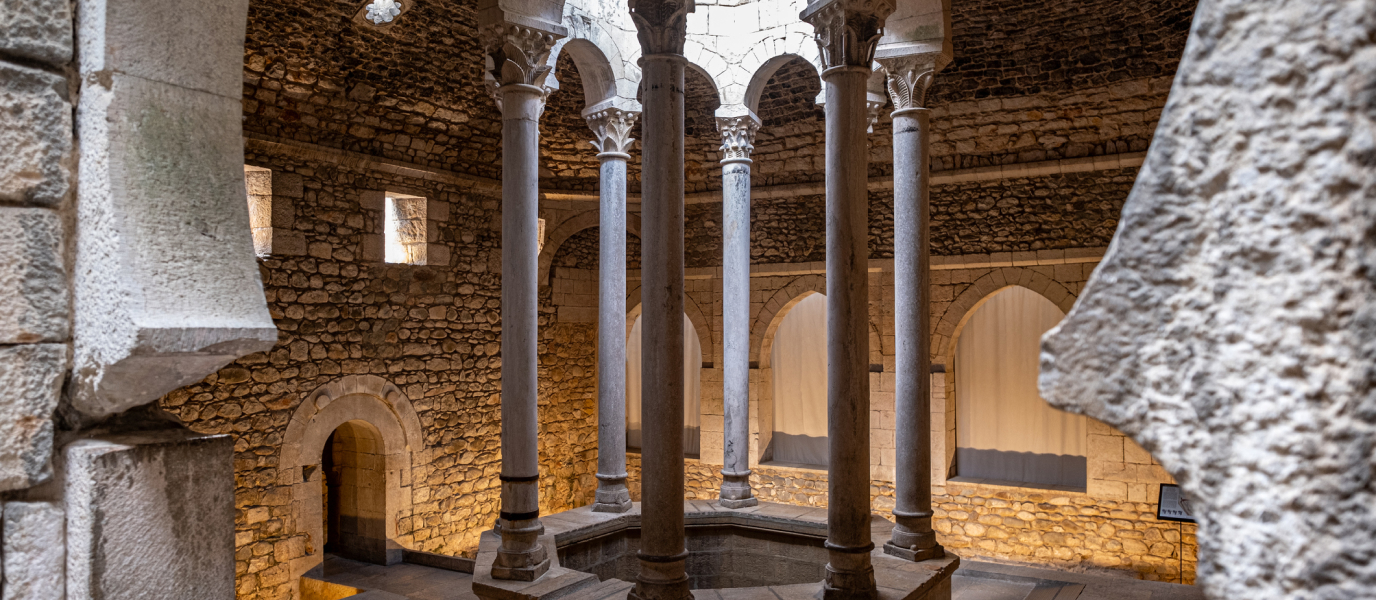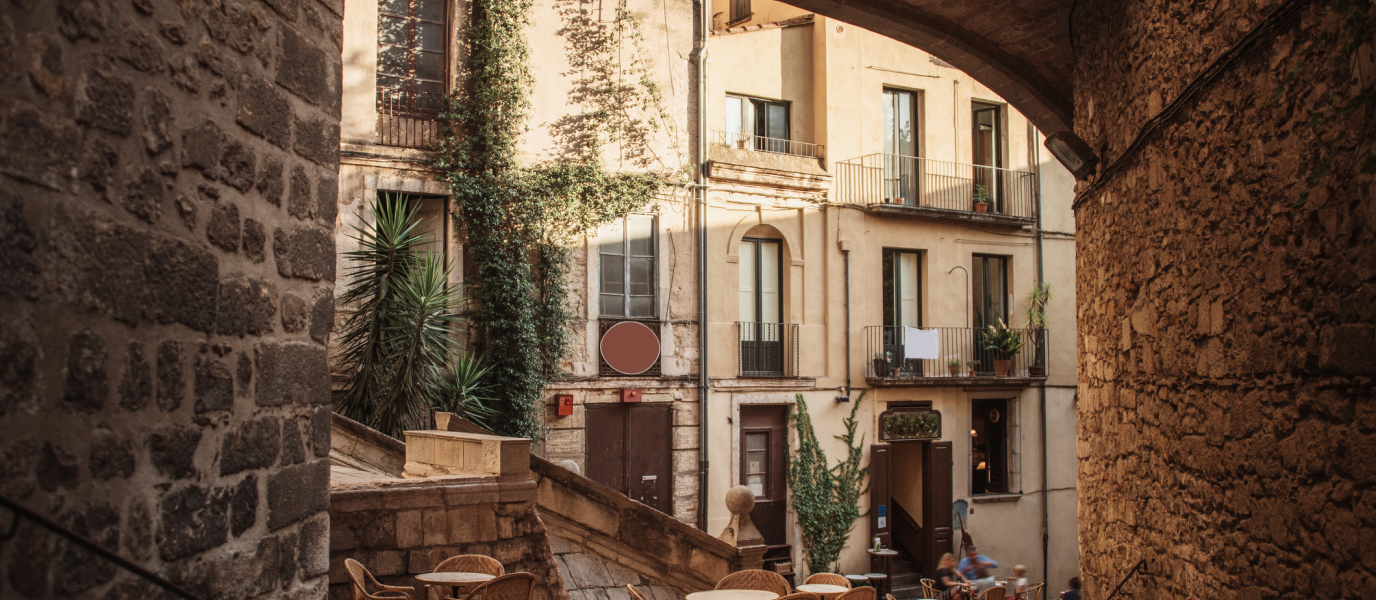At first glance, Cadaqués looks like a Costumbrista painting. Natural and man-made hues harmoniously combine to create an idyllic setting where the most striking colours are the white of the houses, blue of the sea and sky, and emerald green backdrop to each cove.
It’s no surprise that the artist Salvador Dalí chose to live in Cadaqués and the small bay at Portlligat for much of his life. His house became a refuge for numerous artist and intellectual friends who turned what was once a small fishing village into one of the most important meeting points for mid-20th century art.
Context and history of Cadaqués
The Iberians were among the first inhabitants of Cadaqués and cannot have failed to appreciate its beautiful setting in the heart of Cap de Creus. The Greeks later used it as an occasional trading port and stopping point on the way to what is today the archaeological complex of Empúries (link to corresponding URL?).
In the Middle Ages, the village was closely linked to the nearby monastery of Sant Pere de Rodas (link to corresponding URL?), supplying the monastery with fish and enjoying an ongoing social and cultural relationship.
Cadaqués was surrounded by walls in times past but today only part of a tower remains. The walls were needed to defend it from attacks by privateers and Barbary pirates, a common threat along the whole Mediterranean coast until well into the 19th century.
In the 20th century, the charms of Cadaqués were discovered by many internationally famous artists, including Dalí, who first holidayed in the town with his parents when he was nine years old. Picasso, Max Ernst, Magritte, Pau Casals and Eugeni d’Ors all stayed here at one time, as did Federico García Lorca and Luis Buñuel, who were close friends of Dalí in their youth.
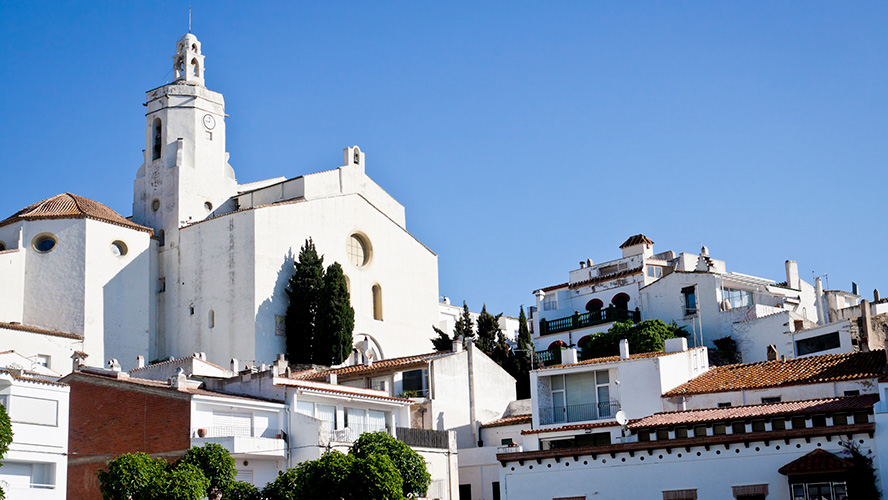
A walk around the old town
Cadaqués old town is set around the church of Santa María, opposite the bay and Platja Gran. The old town is a labyrinth of steep, narrow streets, small squares and viewpoints that look out over the sea and mountains. The streets are paved with rastell, a typical type of cut stone excavated from the coast, and lined with whitewashed houses with brightly painted door frames, window shutters and balconies.
Cadaqués old town was once the original medieval layout of the walled village. All that remains of the walls today is one of the bastions, a structure that has been incorporated into the Town Hall building.
Two of the most picturesque streets are Es Call, with its colourful bougainvillea hanging from many of the balconies, and Santa María, which follows an idiosyncratic curve and is also decorated with bright flowers.
Church of Santa María
The church of Santa María is the most important monument in Cadaqués and it stands out in the city skyline more than any other building. The church was built in the middle of the 16h century in the Late Gothic style. It was constructed on the site of an earlier church that was destroyed during an attack by Turkish corsair Barbarossa in 1543.
The most notable piece inside the church is the Baroque high altarpiece. It’s one of the finest examples of the Vic sculptural school and was made by Pau Costa and Joan Torres. There are a further nine masterfully executed altarpieces in the church, housed in different chapels.
The organ is also a hugely important feature of the church of Santa María; it was made at the end of the 17th century by expert organ builder Josep Boscà. It’s one of the oldest in Catalonia and revered as a fabulous treasure for performing religious music.
Salvador Dalí House Museum
As mentioned above, artist and creative genius Salvador Dalí lived in Cadaqués for several decades. His house, where he resided with his muse and the great love of his life, Gala, is today one of the most-visited museums in the area.
It’s one of the main stops on a cultural journey you can take based around the life of the painter and sculptor that also includes the Dalí Theatre Museum in Figueres (link to corresponding URL?) and the Gala Dalí Castle in Púbol (link to corresponding URL?), where he spent his final years.
The Cadaqués museum is in the bay of Portlligat and was originally a fisherman’s hut that Dalí bought, refurbished and expanded to make it his home and workshop. He lived and worked here until Gala’s death in 1982, leaving a large part of his creative legacy at the house. This heritage is what you can see here today, in addition to numerous personal objects belonging to the couple. The house is an intriguing maze of rooms, staircases, courtyards and whimsically-shaped doors that all work in harmony with the enchanting seaside setting.
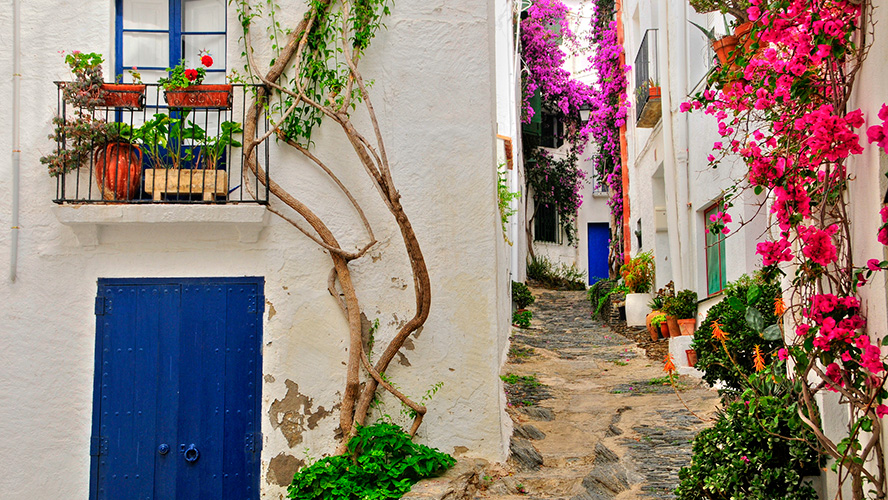
Cap de Creus and Cadaqués Lighthouse
Cadaqués sits on the Cap de Creus geographical formation, a large and precipitous rocky promontory that penetrates the sea at the far north-east of the Iberian Peninsula. It’s framed by El Port de la Selva to the north and Roses to the south, two towns that are well worth visiting.
Cap de Creus has been made a Natural Park and is legally protected by the autonomous region; it is also part of the Natura 2000 network and a Special Protection Area for Birds (ZEPA). It more than earns this institutional recognition because it’s one of the most valuable, diverse and impressive protected spaces in this part of the Mediterranean.
It’s also a fascinating area from a historical perspective and is home to Sant Pere de Rodas, the monastery mentioned above. Sant Pere de Rodas is one of the main religious complexes in Catalonia; it was built over 1,000 years ago and its domains once covered two thirds of Cap de Creus.
The cape is full of places with spectacular views of the landscape and impressive coastline, such as Cadaqués Lighthouse in Cala Nans, which opened in 1874 and has been an architectural emblem of the area ever since. The lighthouse can be reached from the centre of town by walking along a lovely 6 km trail.
Nearby coves and beaches
The following coves in Cadaqués municipality are highly recommended for their beauty and authenticity:
Cala Guillola
Cala Guillola is reached along a narrow path that starts near Cap d’en Roig. Despite its small size (it’s just 10 m wide and around 50 m long), it’s worth visiting to experience being in a place that has been virtually untouched by human hand.
Cala Culip
You get to Cala Culip by walking along a path next to the car park by the information point in Cap de Creus Natural Park. It’s a great snorkelling spot thanks to its crystal-clear waters and abundant sea life. Cala Culip is also a good place to visit with children because the beach slopes gently into the sea.
Cala Bona
This rocky cove is barely 8 m wide but is perfect for finding shelter on really windy days and is a wonderful place to feel totally in harmony with the surrounding nature.
Sa Sabolla
This cove is harder to reach because it’s reached via a steep, narrow stairway, but it’s worth the effort (and possible vertigo) to enjoy one of the most beautiful coves in the Cadaqués area. It’s an utter delight and one of the best places to swim in stunning surroundings.
Where to eat in Cadaqués
Cadaqués has plenty of restaurants, bars and terraces where you can eat a variety of cuisines at different price ranges. One of the best-loved by diners and the specialised media is Compartir Cadaqués (Riera Sant Viçenc, s/n), the first restaurant by the team of Oriol Castro, Mateu Casañas and Eduard Xatruch, who met years back in the El Bulli kitchen and are also behind Disfrutar (2 Michelin stars) in Barcelona. Compartir Cadaqués serves a wide selection of Mediterranean dishes and is perfect for eating out as a group in a captivating atmosphere, either on the terrace or in the dining room.
Celeste (Nou 1) is more down-to-earth and this temple to Mediterranean cooking serves food with a firm Italian flavour. The pasta is both top-notch and authentic, just like the other ingredients used in each dish: salmon, tuna, cod, bresaola, pesto, burrata, octopus, swordfish… It also has an unbeatable location by the sea.
If you’d prefer sandwiches, tapas and/or full portions, head to Es Bar de Dalt (Carles Rahola, 2). Star dishes include the selection of croquettes (chicken, bread and tomato, cuttlefish, Iberian ham, Gorgonzola), anchovies with bread and tomato, smoky grilled vegetables, and breaded or grilled fillet.
Finally, La Sirena (Call, s/n) is a great spot to enjoy delicious dishes of Mediterranean rice, freshly caught fish and excellent Mediterranean seafood, all prepared in the wonderful seafaring tradition of the area.

The best hotels in Girona province
The Hotel Roses Platja, next to Cap de Creus and very close to Cadaqués, is right on the sea front. The hotel is also very near the centre of Roses and has 167 fully equipped rooms where you’ll enjoy a wonderful holiday or short break with your partner or family.
Facilities include a pool and solarium, set among large gardens that lead directly to the beach. It also has a fantastic buffet restaurant where you can sample many of the best dishes of the Mediterranean. And should you feel peckish between meals, you can stop off at the snack bar which has a large outdoor terrace with fantastic sea views.




































































